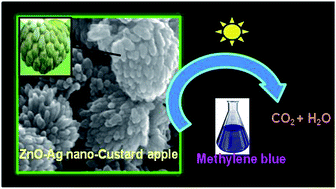Biogenic synthesis of ZnO–Ag nano custard apples for efficient photocatalytic degradation of methylene blue by sunlight irradiation†
Abstract
Photocatalytic degradation of pollutants will be attractive if the degradation process is under direct sunlight in the presence of a cost effective catalyst. We have synthesized a novel, monodispersed ZnO–Ag nano custard apple (NCA) using pomegranate peel extract as reducing and stabilizing agent. The ZnO–Ag NCA was characterized by various spectroscopic and microscopic methods. The photocatalytic performance of ZnO–Ag NCA was evaluated using the degradation of methylene blue dye in the presence of direct sunlight. It was observed that NCA show ∼40% and 24% enhanced photocatalytic activity compared to commercial ZnO nanoparticles and TiO2 (P25). Moreover, the performance of the photocatalyst NCA has been examined in the presence of oxidative reagents such as peroxomonosulfate (PMS), peroxodisulfate (PDS) and hydrogen peroxide (H2O2). The mineralization data of methylene blue, performed by total organic carbon (TOC) analysis, revealed that 95% and 70% mineralization was achieved in 3 h using a NCA–PMS combination and NCA, respectively. The catalyst did not lose its catalytic activity for up to five cycles. Overall, this system is relatively inexpensive, reproducible, extremely stable and efficient for complete degradation of methylene blue in aqueous solution.


 Please wait while we load your content...
Please wait while we load your content...